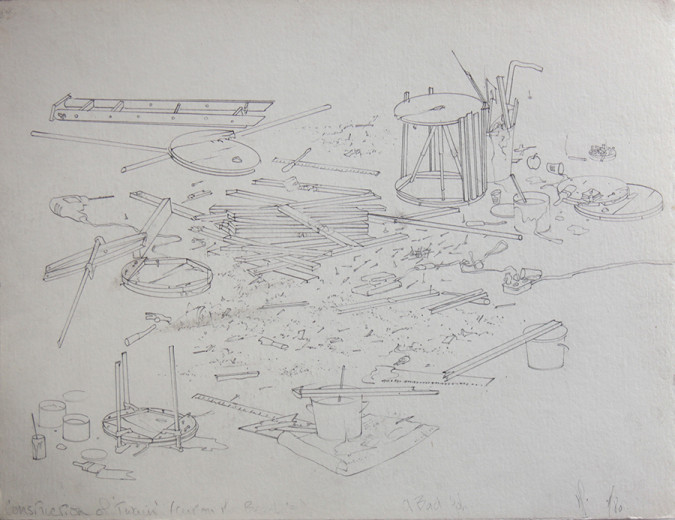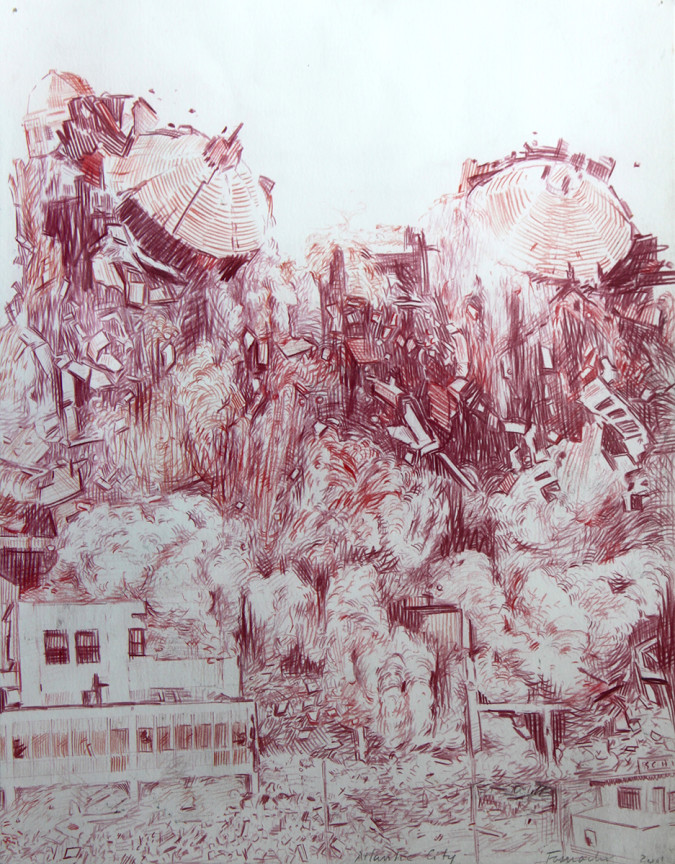Heide Fasnacht
Heide Fasnacht has shown an abiding interest in states of instability. These concepts have been explored through drawings, large-scale sculptures, photo-based work, and prints. The aftereffects of historical occurrences (iconoclasm), risk economics (implosions) and geological processes (earthquakes & implosions) are revealed in fracturing and damage. Deforming and reforming reveals fissures: damage and contortions on the landscape, in culture, in the built environment. Fasnacht’s process reflects these shifting events in both content and process. Her works have most recently been on view at Preview Berlin, Qbox Gallery and Art Athina in Athens Greece, Kent Gallery, Socrates Sculpture Park, and the American Academy of Arts & Letters in NYC. Since her first one-person show at P.S. 1 in 1979, Fasnacht has exhibited worldwide. She has been in exhibitions at MOMA, The Aldrich Museum for Contemporary Art, RAM Galerie, Rotterdam, Galeria Trama in Barcelona, The Worcester Art Museum and many others.
Question:
In 1979 you were drawing a pile of debris at Bennington College. Your recent sculpture, at Socrates Sculpture Park which can also be seen as a 50’ drawing, connects directly to these earlier works. Can you discuss this connection and talk a bit about why drawing by hand still feels connected to your practice?
Answer:
I recently came across these drawings from ‘78 to ’81 that, much to my surprise, held the key to my more recent work. Initially, it was a reaction to a large scale public work that I had made for Creative Time’s Art on the Beach, on the landmass created by the dumping of material to create the footprint for the WTC. My project had been vandalized. I returned from a stay at Yaddo to find debris and broken elements littering the site of my piece. I decided to chronicle, in a speculative way, the undoing of my work. The resultant drawings read almost as a story board of the evolving reduction of the whole into parts, ever tinier, ever more atomic.
During a stay at Bennington one year later I continued these drawings by depicting with stubborn accuracy the sculpture junkyard behind the studio building. In essence, I was granting the status of thinghood to these castoffs and fragments. I wondered if the sculpture that I had made with great care, control and planning was more or less interesting than recording the specifics of these landscapes of detritus in hand drawn form.
I subsequently made a few sculptures that crashed and fragmented, recording these objects and their demise as well in drawings.
While these interests went underground they by no means disappeared. My early wood pieces, while whole objects, evolved into ever more fragmented parts.
But I returned to my earlier interests, oddly, through photographic reproduction: A chance discovery in an old encyclopedia discovered in a thrift shop during a teaching gig at the Atlantic Center for the Arts. A photograph of a man sneezing when enlarged revealed a concatenation of raster dots and droplets.
I found more and more images that are particulate in nature, and further particularized (i.e. raster dots) in the photographic reproduction. Volcanoes and geysers, bomb tests, confetti, and other singular moments became drawings and sculptures. The content, beyond the pseudo scientific, revealed social and cultural fissures and shifts, humanizing the work.
But one great cultural fissure visited my neighborhood and brought the reality of what I was doing close to home: The attack on the World Trade Center. On my desk that morning was a drawing, “Three Buildings” depicting a building under construction, a completed building, and one being demolished. After that I abandoned the imagery I had been working with since 1997. What followed were a series of paintings of water droplets, so still not to far afield from my original concerns.
In the years since 9/11 I have considered why I had made the work I did, and the uncanny resemblance to that event, though I had made the work beforehand. I awakened to the political, environmental and social costs that these events are caused by and result in. Returning to the imagery of fragmentation I am locating it more specifically in the realm of environmental and economic disasters (geoogical faults and implosions of casinos).
So why does all of this have to be rendered in drawing by hand? To answer this it is important to understand the how and why of my drawing process.
When I draw I feel the thing in all of its 3-D density, it’s broken edges and vertiginous tilt, a kind of body empathy with the forces within the objects. It is limning a plan to reconstruct. It involves, insofar as is humanely possible, not projecting my own ideas of how it should be, but rather recording things as they are (ding an sich). But it is not solely a mental or intellectual exercise, it is felt through the nervous system encompassing balance or wobbliness, integrity or fracturing, newness or wear, usefulness or beyond use. etc. This is a bodily experience of the vibrancy of forces acting on and through objects.
It is also my first language. I have learned Italian, German, Photoshop, Sketchup and Illustrator, but they are second languages. I understand them through my more thoroughly corporeal practice of physical pencil on physical paper.
And finally, the drawings are plans. To not make up a sculptural form, but to recreate the singularity of an existing very imperfect form requires a lot of looking without prejudice. In preparatory drawings for the casino “Last Frontier” I researched and found no fewer than 11 different photographs of the debris pile after its implosion. I chose the most comprehensive and readable for the first drawing and hewed closely to it. I drew the other views as plans to rebuild the pile of rubble as closely to its singular form as I was able. The actual pile, of course, is no longer in existence, having long ago been replaced with a larger more spectacular casino.
One Question/One Answer is a series of very, very brief conversations about art and life between Romanov Grave and a variety of extraordinarily interesting artists.









She’s the bomb! Literally.